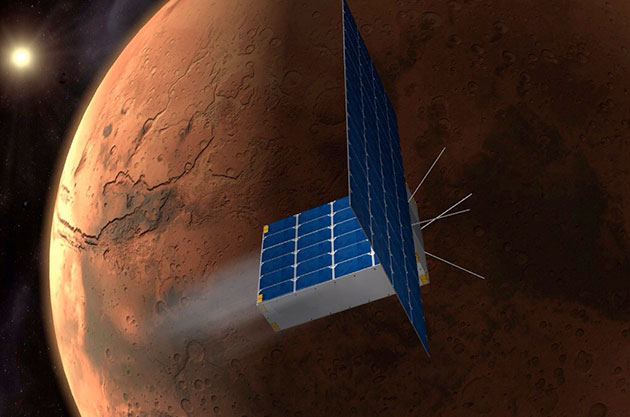New Ion-Propulsion System Could Deliver Time Capsule to Mars

WASHINGTON — A student-led mission aims to send a time capsule to Mars, using a new, more compact kind of propulsion system.
The Time Capsule to Mars mission is designed to bring three tiny "cubesats" containing photos, videos and other media provided by people around the world to the Red Planet, using "ion-electrospray technology." This new kind of propulsion system could deliver the cubesats to Mars in as few as four months, the mission's organizers say.
Traditional thrusters burn chemicals to produce thrust. By contrast, ion-propulsion systems use electrical energy to accelerate particles, which is much more efficient, said Paulo Lozano, director of the Space Propulsion Laboratory at MIT in Cambridge, Massachusetts, where the mission, supported by the nonprofit organization Explore Mars, is centered. [The Wildest Private Deep-Space Mission Ideas]
Each cubesat will be 3.9 inches (10 centimeters) on a side, so it won't have a lot of room for engines. "They need a small rocket that consumes very little propellant," Lozano told Space.com. This is what the new propulsion system brings to the table, he added.
Ion engines have been around for many years, but are too bulky and expensive for this mission, Lozano said. In addition, they usually involve a gas, which requires a large volume to ionize.
About 10 years ago, Lozano and his colleagues came up with a way to miniaturize these engines. Instead of using a gas, the researchers apply a strong electric field to a liquid-salt propellant. Using this ion-electrospray technology, only a small amount of propellant would be needed to get the miniature spacecraft to Mars from Earth orbit, he said.
A traditional ion engine is big, and making it smaller is difficult. "We have [the] opposite problem," Lozano said — the thrusters he is using are tiny, so the team needs to use a lot of them to generate enough thrust.
Get the Space.com Newsletter
Breaking space news, the latest updates on rocket launches, skywatching events and more!
Each of the mission's three cubesats will contain 40 thruster pairs, which Lozano's team can make using micromachining techniques.

The new thrusters are significantly less expensive than other ion engines because they are batch-produced, Lozano said. In addition, spacecraft designers wouldn't have to develop a new thruster for every mission, like they do today, he said.
Lozano said his team is under contract with NASA and the Department of Defense to develop the new ion-propulsion system. "We're on the second generation," he said, "and we plan to fly them early next year for the first time."
Time Capsule to Mars leaders have said they hope to launch the mission in the next five years, if they're able to raise enough money.
If the propulsion system is successful, it could be used on other spacecraft — possibly even manned spacecraft, Lozano said. However, for this the engines would need to be very well tested.
"If we take humans to Mars, we have to be very careful," he said.
Follow Tanya Lewis on Twitter and Google+. Follow us @Spacedotcom, Facebook and Google+. Original article on Space.com.
Join our Space Forums to keep talking space on the latest missions, night sky and more! And if you have a news tip, correction or comment, let us know at: community@space.com.










